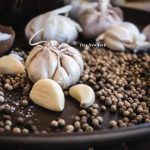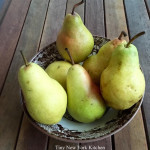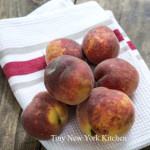Here in the Northeast we often think of there being a short growing season. In other regions, many people garden as if there’s a beginning and an end as well. But gardening, anywhere you do it, is circular. There may be slow times, but planning ahead for what’s around the bend is crucial.
Right now, I’m thinking about next year’s garlic. Here we are, another turn of the season. Cool days and nights are creeping in and it’s really quite wonderful that one of the last planting tasks in the garden is getting garlic in the ground. Planting in general may feel counter to all the other fall tasks, but when you plant garlic you are “putting it to bed,” since it needs a cold cycle to perform well. On the other hand, the very act of planting-looking forward to spring and summer and harvest- brings the cycle of the seasons together quite nicely, proving that a garden never really begins or ends; it only changes.
Ho much you plant depends on what you want out of your crop. One pound of garlic can plant between 15 to 30 feet depending on the variety, and the amount of space you give it. Space rows 12 inches apart in whatever bed system you use.
If you would like to produce your own seed stock and your own eating stock, plan to reserve the top 30% of your harvest for planting. Each pound of garlic can produce between 50 to 75 heads of garlic, since each clove can produce a head.
When following a vegetable rotation schedule, one knows where the garlic will be planted well ahead of time. This gives an opportunity to make sure the beds are well worked, weeded, amended and prepared.
Garlic prefers rich, well-drained, and weed-free soil located in full sun. Ideally, choose a spot that is in full sun from winter through spring. It can be difficult to grow a crop in your weediest beds, so consider this when location scouting during the summer.
Compost, aged manure, and weed-free hay or straw mulch are good choices. Give yourself plenty of time to get this sorted out.
A few days prior to planting, prep your site.
Choose a sunny day in October when the soil is still warm. Try to leave enough time before the ground freezes solid for the garlic to set roots. Garlic can be planted any time before the ground freezes solid, though, ideally 3 to 6 weeks prior.
Begin by breaking apart the heads of garlic into cloves. Count the cloves and determine the amount of space you need. Most hardneck varieties have 50 to 90 cloves per pound. Garlic prefers full sun, so choose a spot that will get full sun for the spring and early summer. Each clove will be planted at 6” spacing, in rows 12” apart. Weed and work a proper amount of garden space. After cultivating the space, mark the rows. Plant cloves root side down, 2” deep, at least 6” apart, in rows 12” apart. Water and cover with mulch. Your garlic will need to be tended to in the spring, once the ground warms and it begins to grow.
Spring growing conditions and care: Garlic begins to poke through the ground as soon as the soil warms. If you covered your garlic with a thick mulch layer, rake it back to help warm the soil faster.
Garlic prefers rich, weed-free soil and ample water. Beginning in the spring, pull weeds when small, taking care not to damage your garlic when pulling them out. Hardneck varieties produce garlic scapes in the spring. If left on the plant, the scapes will draw energy from the bulb, reducing size and quality. Once the scapes emerge, cut them off immediately to direct the plants’ energy into bulb production. The scapes are an edible spring delicacy.
Giving your garlic a nutrient boost in the early spring is highly recommended. Garlic performs well with a nitrogen boost in the form of alfalfa meal, or a light side-dress of compost.
©Tiny New York Kitchen © 2020 All Rights Reserved
On fall evenings I often like to sit by the fire and sip a nice glass of wine or a sweet & tart cocktail.
Summer returned to New York City this week. Yesterday, the mercury topped 82 degrees, which is unheard of for mid-October. New Yorkers are soaking up the “July in October” weather, walking around in summer clothing and eating lunch in the parks.
Even though the weather is unusually warm, it’s wonderful to see apartment buildings and shops adorned with autumn decor. Even corner bodegas decorate with pumpkins and and scarecrows. This is one of the things that I love about New York City!
“Work With What You Got!”
© Victoria Hart Glavin Tiny New York Kitchen © 2016 All Rights Reserved
Pears
Season: June to October, but can be cold-stored until spring.
Pears are one of the few fruits that should be picked when under ripe. Buy hard pears a few days before you need them, and let them ripen at room temperature until they have a slight yield when given a gentle squeeze.
To core a pear, cut the pear in half lengthwise, and then scoop out the hard portions with a melon baller. Pear flesh (like apple) oxidizes when exposed to air, so rub the cut areas with lemon juice or white wine to keep them from turning brown.
“Work With What You Got!”
© Victoria Hart Glavin Tiny New York Kitchen © 2016 All Rights Reserved
Because peaches can grow in most of the United States, as long as they’re in season (May through early October) chances are you’ll be able to find organic peaches near you. Look for peaches with flesh that yields slightly to subtle pressure without bruising. Another good indicator of ripeness is the fruit’s background color, behind the red highlights. For yellow peaches (the more tart variety), the background should be a deep gold; for milder white peaches, give them a sniff – they should have a rich, sweet fragrance.
“Work With What You Got!
© Victoria Hart Glavin Tiny New York Kitchen © 2016 All Rights Reserved










